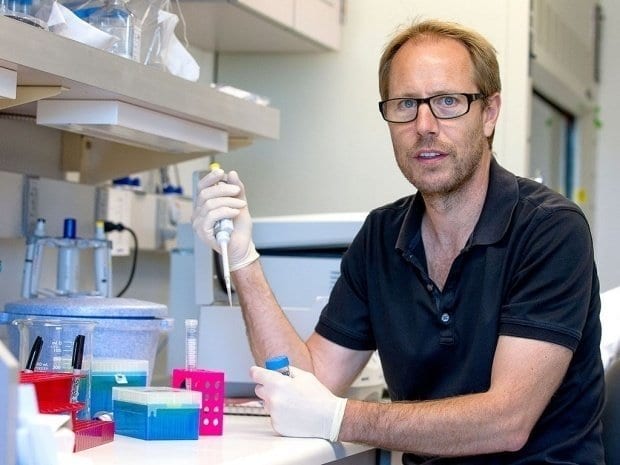
A research team at the VIB-KU Leuven Center for Microbiology has developed a novel screening method to identify antimicrobial properties of volatile substances. With this assay, they tested the vapour-phase-mediated activity of 175 essential oils (EOs) and 37 EO components. Approximately half of them proved active against the most drug-resistant type of Candida. In a context of fungi showing increasing drug resistance, these findings may be useful in both medical and agricultural applications.
The research project, led by prof. Patrick Van Dijck, is rooted in the growing problem of antifungal drug resistance. Candida cells, for example, are quickly becoming tolerant to fluconazole, the most-used antifungal drug. Next to exploring experimental new techniques, scientists also seek to repurpose existing substances. Plant essential oils (EOs), metabolites obtained by steam distillation or cold citrus peel pressing, may offer interesting opportunities: they are made up of compounds that help protect the plant against microbial or herbivore attacks.
Identifying EOs and their compounds
In the VIB-KU Leuven Center for Microbiology, Adam Feyaerts gathered a collection of 175 different EOs, constituting a collection of over one thousand different small molecules. The aim was to identify biologically active compounds present in these complex mixtures. They therefore developed a new class of assay that allowed to identify new volatile substances with antifungal activities over a distance.
Prof. Patrick Van Dijck (VIB-KU Leuven): “We screened our whole collection of EOs for vapor-phase mediated antifungal activity against two human fungal pathogens, Candida albicans and Candida glabrata. Interestingly, we found that approximately half of the EOs and their compounds had vapour-phase-mediated activity against bothCandida species. Surprisingly, C. glabrata, the most drug-resistant species of the two was on average even more susceptible. In contrast, none of the currently used antifungals showed any vapour-phase-mediated activity.”
Numerous potential applications
This is now the first simple test to look for the vapor-phase-mediated antimicrobial activity of molecules. The same assay could also be used to test other biological activity. And although these findings still have to be confirmed in clinical trials, potential applications are numerous.
Co-author Adam Feyaerts (VIB-KU Leuven): “Our findings are for instance a starting point for the development of molecules that could also be used in vaporizers. After all, volatiles can access otherwise hard to reach areas. Think of possibilities such as maintaining hygiene in hospitals or treat patients with lung infections. There are agricultural options too, such as preventing post-harvest contamination or protecting crops against pests.”
Learn more: Plant-derived volatiles may serve as future antifungals
The Latest on: Antifungal drug resistance
[google_news title=”” keyword=”Antifungal drug resistance” num_posts=”10″ blurb_length=”0″ show_thumb=”left”]
via Google News
The Latest on: Antifungal drug resistance
- Infectious worms may offer insight into antibiotic and pesticide resistanceon April 23, 2024 at 11:39 am
One UC Riverside scientist has been awarded $1.9 million to decode nematodes’ attack strategies, and combat resistance issues.
- Combination Antifungal Therapy for Invasive Fungal Infections in Children and Adultson April 20, 2024 at 5:00 pm
Currently, there are no clear-cut recommendations for efficacious antifungal combination in these ... without a major concern about drug-related side effects. [74] However, only 30 patients ...
- Mitigation of Human-Pathogenic Fungi That Exhibit Resistance to Medical Agents: Can Clinical Antifungal Stewardship Help?on April 6, 2024 at 5:00 pm
Evidence for resistance is growing Several antifungal resistance mechanisms are now known, including: drug efflux, alterations in drug targets, changes in cell membrane and lipid composition ...
- Researchers report rise in global fungal drug-resistant infectionson March 18, 2024 at 12:00 pm
The emergence of multidrug-resistant fungal species, such as Candida auris ... in addition to becoming drug-resistant, was also sexually transmissible. To address the growing health concern ...
- Rising antifungal resistance heightens concerns over invasive fungal infectionson March 17, 2024 at 5:00 pm
A global wave of infections caused by fungi growing drug-resistant has the medical ... explain how rising antifungal resistance is worsening the problem of invasive fungal infections.
- The threat of fungal infections is growing. Why is it so hard to make new drugs?on February 11, 2024 at 3:06 am
In late 2022, the WHO published their first-ever list of fungal priority pathogens — 19 fungi the agency said pose a significant threat to human health. It includes the highly drug-resistant ...
- Fighting the rising tide of antifungal resistance: a global challengeon May 18, 2023 at 4:07 am
In recent decades the problem of antibiotic resistance has been a primary focus for many organizations, with less attention directed towards antifungal resistance. The tide is turning, however.
- First Cases of Drug-Resistant Ringworm Detected in U.S.on May 17, 2023 at 4:59 pm
Scientists studying the condition suspect that the fungus may have become drug-resistant due to the misuse and overuse of topical antifungal treatments and corticosteroids (anti-inflammatory ...
- Antifungal tolerance in Candida auris contributes to treatment failureon March 22, 2023 at 5:00 pm
Scientists are particularly concerned about antifungal resistance because of the limited number of classes of antifungal drugs. Surprisingly, no new class of antifungal drugs has reached the ...
- NHS implements antifungal resistance teston September 11, 2020 at 3:11 am
Standard treatment is to give what are known as the triazole class of antifungal drugs. However, there has been a significant worldwide increase in resistance to these medicines. “Early and accurate ...
via Bing News










